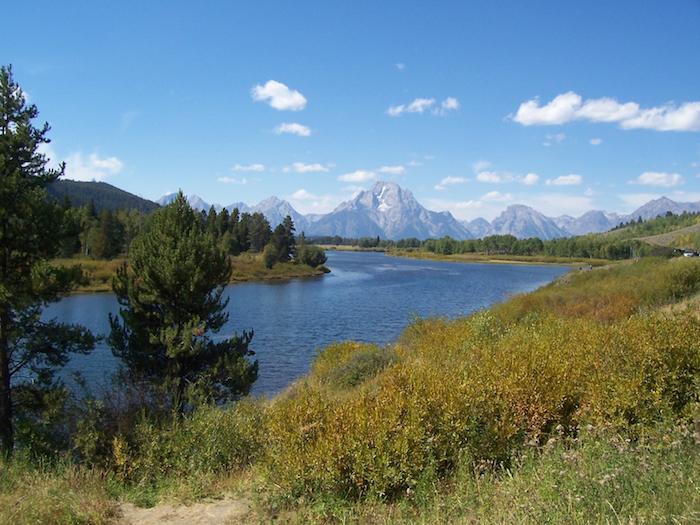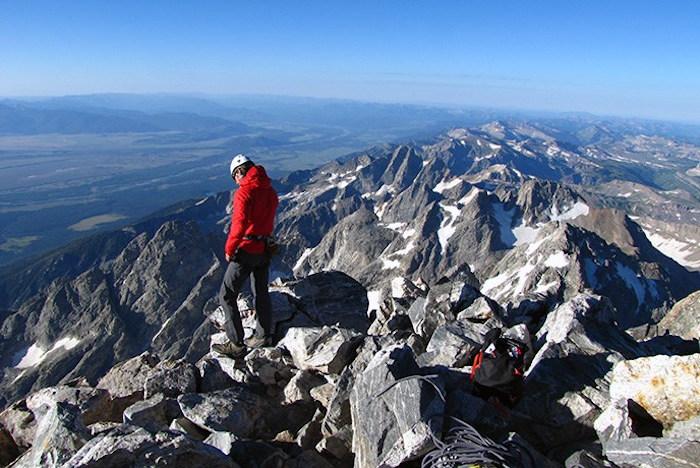
Foresight by John D. Rockefeller, Jr., and Horace Albright preserved the scenery held within Grand Teton National Park/NPS
Standing atop Grand Teton, it's easy to see the handiwork of Horace Albright and John D. Rockefeller, Jr. To the southeast is Timbered Island, almost directly below is Jenny Lake, and a bit to the northeast is Jackson Lake. Not in view are the "shabby developments littering the roadway from Menors Ferry to Moran and along Jenny Lake’s south and east shores" that Mr. Rockefeller and Albright, then Yellowstone National Park's superintendent, saw in 1924.
It's due almost entirely to their foresight that Grand Teton National Park was enlarged beyond its famous peaks and the pearls known as String, Leigh, and Jenny lakes that are draped along the mountains' feet, and that those "shabby developments" were removed and not replaced by newer structures that would intrude on the setting.
While Mr. Rockefeller created a shell company, the Snake River Land Company, to quietly buy up acreage fronting the mountains, efforts were made in Congress to enlarge the park. When those efforts stalled, Mr. Rockefeller threatened to sell the 35,000 acres the Snake River Land Company had acquired.
In an historic letter to President Franklin Delano Roosevelt, he wrote that if the federal government did not want the gift of land or could not “arrange to accept it on the general terms long discussed…it will be my thought to make some other disposition of it or to sell it in the market to any satisfactory buyers." This threat persuaded FDR to use his presidential power to proclaim 221,000 acres as the Jackson Hole National Monument on March 15, 1943.
... On September 14, 1950, the original 1929 Park and the 1943 National Monument (including Rockefeller’s donation) were united into a “new” Grand Teton National Park, creating present-day boundaries.
Today we can truly appreciate the efforts Rockefeller and Albright took to preserve this magnificent setting.
Soaring to nearly 14,000 feet atop the granitic tip of its namesake peak, the park’s jagged crags and their snowfields quickly catch your eye -- and hold it -- from anywhere in the Jackson Hole Valley. The abruptness with which the Tetons climb out of the valley, their easy access, and the countless climbing opportunities, combine to define the range as one of mountaineering's classics.

Stop by Menors Ferry for a history lesson/NPS
But there’s much more to do in this wondrous park than grab a rope and ice axe and climb to the roof. There's the Snake River for angling and paddling, the string of shimmering lakes nestled at the base of the Tetons for exploring by canoe or sea kayak, hiking trails that allow you to escape the crush of humanity, and rich wildlife resources to spot.
Campers have hundreds of sites to choose from in the front-country, while backpackers have hundreds of miles of trails to follow high into, and across, the mountains. Easy trails cater to families with young children as well as folks just looking to savor the scenery and build an appetite for dinner.
Visit during the summer months and the task at hand is to avoid the crowds. That's fairly easily done by heading down a hiking trail. True, Cascade Canyon is perhaps the most heavily traveled trail come warm weather, but few folks seem to move on beyond Inspiration Point. If you take this trail, enjoy the view from the point and then push on further up the canyon. In places where the creek pools I've seen moose browsing for a soggy meal.
If you prefer not to deal with the elevation gain, head north on the trail that wends its way along the shore of Jenny Lake and continue on to String Lake. Pack a lunch and a swim suit and, if the day is warm enough, enjoy an afternoon along either Leigh Lake or String Lake. Neither allow motorized boats, so you won't have that noise to contend with. Plus, the shallow nature of String Lake makes it perhaps the warmest lake in the park, perfect for a swim. Leigh Lake is decidedly colder.
If you're interested in how the park came to be, check out the Menors Ferry Historic District, where you can learn about Mr. Albright's secret meeting in Maud Noble’s cabin on July 26, 1923, to discuss efforts to protect the landscape from being overrun by development.

Oxbow Bend below Jackson Lake is a great place to look for wildlife/NPS
Feel like a hike? Stop by the Laurance S. Rockefeller Preserve, which provides great opportunities to learn about the natural world, then head out on the trail to Phelps Lake. From the trailhead at the preserve you can access more than 8 miles of trail...much more if you head up the Death Canyon Trail and wander deep into the park's backcountry. Grizzly bears do roam this landscape, along with black bears, so be sure to carry bear spray, travel in groups, and let the bears know you're out there.
The Phelps Lake Trail is relatively flat and definitely family-friendly. While you don't have the three crags of the park's iconic mountains looming overhead, this hike does provide you with a nice mix of lodgepole/spruce forest and open meadow along with the lakeshore itself. Pay close attention to the larger aspens, as you just might spot some claw marks left by bruins either climbing into the trees or using them for scratching posts.
For those with more ambition, tackle the Grand Teton itself. The 13,770-foot-tall mountain is an incredible magnet, to climbers and non-climbers alike. It's the biggest stop sign in the West, no matter from which direction you first spy it. Along with the Middle Teton and South Teton, the Grand scrapes the sky with its distinctive "horn," a constant reminder of the glaciers that helped mold the horizon.
Along with a dozen or so other neighboring peaks that rise above 10,000 feet, the Tetons form a ponderous, jagged stretch of rock that is the Lower 48's most arresting mountain range. The soul of Grand Teton National Park, the Grand harbors world-class climbs. Some tackle the mountain on their own, while neophytes such as myself are herded ever upward under the watchful guidance of one of Jackson's two resident climbing outfitters, Exum Mountain Guides and Jackson Hole Mountain Guides.

Find yourself atop Grand Teton/NPS, K. Kanes
Fine with leaving the climbing to someone else while you go in search of wildlife? In August and early September, the Moose-Wilson Road is pretty reliable for black bears, as they come to feast on the tasty hawthorn berries. The bruins are so fixated on gorging themselves that they pretty much ignore the cars on the road. Just remember that they're wild bears and keep your distance. Moose are often seen early in the morning and in the evening in Willow Flats right behind Jackson Lake Lodge. The Oxbow Bend stretch of the Snake River also is famous for its bird-life -- white pelicans, trumpeter swans on occasion, osprey and even eagles. I've also seen otters frolicking on the river banks here, as well as moose.
A great morning or afternoon could be spent floating the Snake River as it flows south out of Jackson Lake and down past Moose, where the park's Craig Thomas Discovery and Visitor Center is located.
Before you leave the park, swing by the Jenny Lake area (that very possibly could be your first stop, as it's the most-visited part of the park), and enjoy the many improvements the Grand Teton National Park Foundation helped the National Park Service afford. Trails have been rehabilitated, there are gorgeous overlooks along Jenny Lake, and many social trails have been erased.
Just remember, Grand Teton National Park is a slice of the wild. It is home to grizzly and black bears, mountain lions and wolves, moose and bison. All can be dangerous if you get too close, so keep your distance, travel in groups, and pack bear spray if you're hiking in the backcountry. High country trails can be covered with snow or ice in early summer, so watch your step. And the Snake River is braided in places; taking the wrong route could spell doom, so go with a guide if you're not experienced in paddling this river.
While a day isn't enough to explore this entire park, it is enough to fall in love with Grand Teton.



Comments
Hello, a group of 4 seniors will be visiting for a week in the last week of October and hope the weather holds so we can see the sights and do a few snow angels.
That sounds like fun. Enjoy!
The trip is awesome! The view is great to.